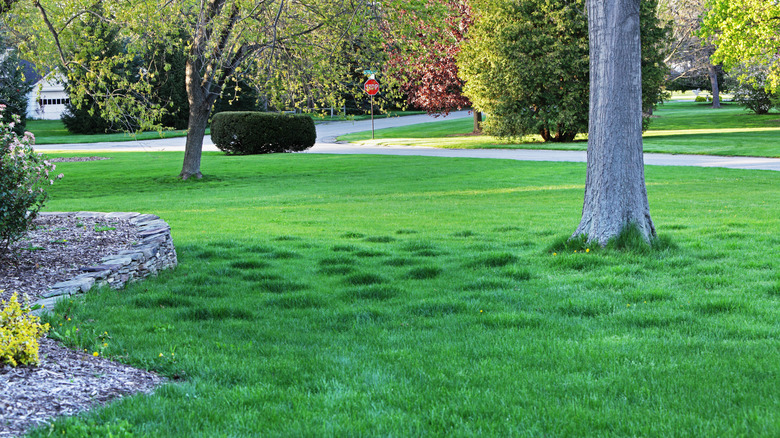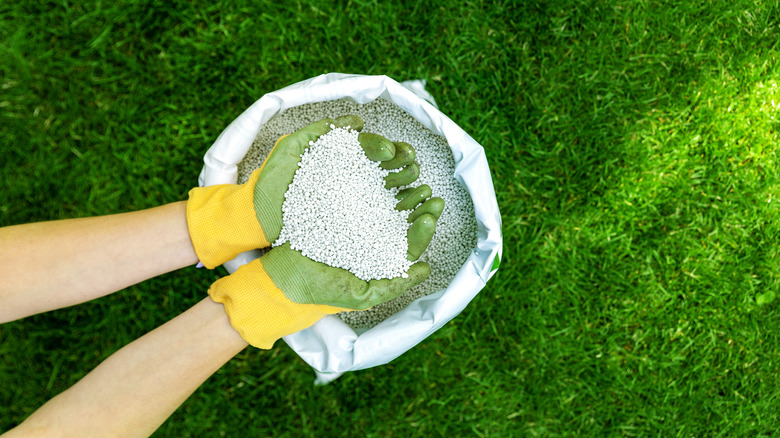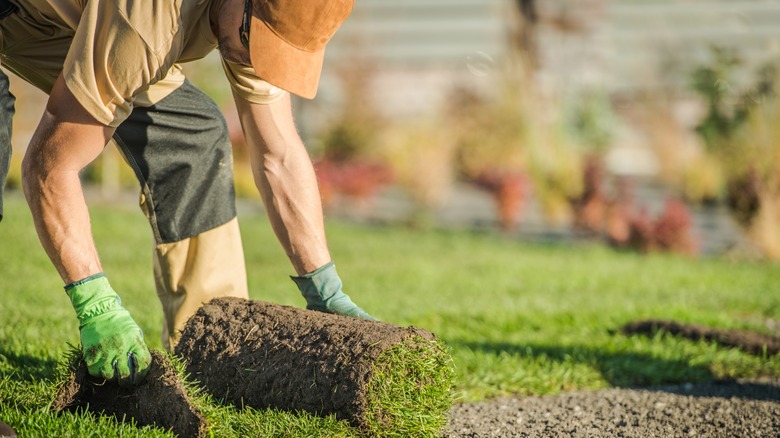The Best Time Of Year To Fix Depressions In Your Yard
Lawn depressions don't just look unsightly — holes collect water, creating literal bogs in your yard. They disappear your gardening tools or your dog's favorite toy. Hidden pits in a lawn can be dangerous, too. If a kiddo steps into one while running full tilt around your backyard, they could twist an ankle or worse. Leveling your backyard to fix depressions is a must-do task for any responsible homeowner, and late spring is the best time to do it. The ground is soft enough to work but not yet boggy from summer rains, and any seeds you put down now will sprout quickly.
Sometimes, a lumpy-looking yard results from construction activities, like workers burying building waste under a lawn instead of disposing of it appropriately. This is less common than other, more natural, and decidedly less nefarious causes: tree removal, poor drainage, erosion, high activity (maybe you once had a wading pool or swing set there), bad mowing practices, or driving on the lawn. Burrowing pests, like moles, voles, and gophers, sink lawns. Uneven thawing of the ground after winter plays a part, too.
A less-than-level yard profile is usually easy to spot — look for the bumps, holes, and dips. Sometimes, depressions are camouflaged or, in large yards with less visited or out-of-view areas, not noticed until it's too late. Identifiers include patches of extra-long, extra-green grass (in spring), snow build-up (in winter), a literal pond forming (during rainy summer and fall), or an uneven feeling when walking over the lawn.
Why late spring?
Lawn care and garden experts alike agree that the best time of year to fix a lumpy backyard is in the spring, ideally right after the last frost. There are a few reasons for this: the soil is moist, it's not yet too hot, and your grass has broken its dormancy. Most importantly, any areas of lawn impacted by your remediation efforts are more likely to recover well. If your yard is made up of a warm-season grass species, you can push that timeframe into early summer. The second-best time is the fall for pretty much all the same reasons; fall is second-best only because, in much of the U.S., lawns go dormant through winter, limiting your chances to finish the repairs.
Sometimes, a simple dressing of fertilizer to boost grass growth is enough to smooth out lumps. Do this in spring and reap the rewards in late summer. Depression fixing work isn't just related to the spring, though. Re-seeding any bare patches created by your leveling activities should be done in the fall, when it's easier to keep the soil damp, encouraging germination. If you want to go the fertilizer route first, buy an all-purpose, all-season lawn fertilizer like Scotts Natural Lawn Food, $37.99 for a 29.1-pound bag, or a 40-pound box of Just Scentsational organic lawn starter, $59.78 at Lowe's.
The how-to
If you don't want to wait a season to see if that fixes your problem, or your depression is quite deep, there are other methods to consider. Another way to deal with minor lumps and bumps is lawn rolling, which consists of pushing a heavy, cylindrical wheel over your yard — the tool sort of resembles a mini, hand-driven steamroller. It's a staple tool for managers of turf-covered sports fields. Big holes need to be filled with, say, compost, soil, or rocks. Sand mixed with topsoil works well, too. Experts advise overfilling the area so you're left with a bit of a mound. Over the next few weeks, this will naturally level out, and you can re-seed the patch with the same species of grass the rest of your lawn features.
To create a less noticeable fix and keep your existing grass, carefully dig out a circle or square of turf, lift it to fill the hole underneath, and lay the grass back on top. Fertilize the patch and keep it well-watered until the turf recovers. Suspect a sinkhole? A hole deeper than chest height qualifies as such. You might need professional help with this problem. Some municipal authorities even ask residents to report incidences of sinkholes, so check if that's the case in your town or city. Likewise, if your backyard resembles a field of roller coasters, it may need to be redone entirely — the entire area will need to be dug up, leveled, and re-seeded.


